- Enhancing Mechanical and Electrical Performance through Polymer Blending: A Study on PVA-PDDA Blended Films for Triboelectric Energy Harvesting
Nebiyou Tadesse Debele*, Alemtsehay Tesfay Reda*, Yong Tae Park*†
* Department of Mechanical Engineering, Myongji University, Yongin 17058, Korea
This article is an open access article distributed under the terms of the Creative Commons Attribution Non-Commercial License (http://creativecommons.org/licenses/by-nc/4.0) which permits unrestricted non-commercial use, distribution, and reproduction in any medium, provided the original work is properly cited.
This study explores the impact of polymer blending on the mechanical properties and triboelectric energy harvesting capability of composite polymers. A multifunctional free-standing polymer blend composed of poly(vinyl alcohol) (PVA) and poly(diallyldimethylammonium chloride) (PDDA) was fabricated using a polymer casting method. Stress-strain analysis of the polymer blend revealed an enhanced stretchability of 308.4% with excellent transparency. Furthermore, triboelectric analysis revealed dynamic energy harvesting capabilities with impressive electrical voltage and current output of 50 V and 5 μA. These results represent a significant improvement compared to individual PVA and PDDA polymers and highlight the potential of polymer blending to enhance both mechanical and electrical properties for energy harvesting applications
Keywords: Polymer, Composite, Triboelectric nanogenerator, Energy harvesting
Triboelectric nanogenerators (TENGs) are considered an effective technology for harvesting a wide range of ambient mechanical energy, as they offer several advantages, including wide availability and material selection, relatively simple device configuration, and low-cost processing. In the ever-evolving landscape of materials science and technology, the demand for versatile solutions has intensified, particularly within sustainable energy harvesting [1].
Energy harvesting technologies have become increasingly important in finding sustainable power sources for a variety of applications, including portable electronics and wearable devices [2]. Among these technologies, TENGs stand out for their ability to convert mechanical energy into electrical energy through the principles of contact electrification and electrostatic induction. Understanding the intricate mechanisms of TENG operation is critical to enhancing its performance and exploring its potential applications [3].
This study investigates the effect of polymer blending on the mechanical properties and energy harvesting ability of composite polymers, particularly focusing on a multifunctional free-standing polymer blend composed of poly(vinyl alcohol) (PVA) and poly(diallyldimethylammonium chloride) (PDDA). This study aims to elucidate the effect of polymer blending on the transparency, mechanical strength, and energy harvesting efficiency of the composite polymer films through rigorous analysis [4].
In addition to characterizing the mechanical properties and transparency of the PVA-PDDA composite films, the study also takes a closer look at the electrical performance of the films using TENG technology. By analyzing the voltage and current outputs of the TENG system, the study aims to evaluate the effectiveness of polymer blends in enhancing energy harvesting compared to individual PVA or PDDA polymers.
Through a combination of experimental analysis and theoretical understanding, this research contributes to the growing body of knowledge on polymer blending for energy harvesting applications [5]. The insights gained from this research have the potential to inform the development of more efficient and sustainable energy harvesting technologies, paving the way for a greener future.
2.1 Reagents
PVA (Mw ~ 89,000-98,000 g/mol) powder, PDDA (Mw ~ 100,000-200,000 g/mol) and poly(dimethylsiloxane) (PDMS) where bought from sigma aldrich.
2.2 Preparation of Films
To prepare the different films, PVA powder at a concentration of 2.5% w/v was initially prepared by mixing it with DI water. The mixture was then heated on a hot plate at 80°C for approximately 30 min. Simultaneously, a PDDA solution with a concentration of 2.5% w/v was also prepared by stirring it in DI water on a hot plate at the same temperature as the PVA solution for approximately 30 min [6]. Subsequently, each PVA and PDDA solution was transferred into a larger beaker, and then both polymers were mixed and stirred using a magnetic stirrer at 300 rpm for about 30 min at 80°C. The homogeneous mixture was then poured into a predefined mold and dried at 45°C for about 48 h. Finally, the dried film was carefully peeled off the glass plate and stored in a desiccator at 25°C for further use. For the counter material, PDMS was prepared by casting. This method ensures the preparation of films with the desired composition and properties for subsequent experiments and analysis.
2.3 Characterization
Fourier transform infrared (FT-IR) spectra of the films were recorded by a Nicolet iS5 infrared spectrometer in the frequency range of 4000-500 cm−1 using the attenuated total reflectance (ATR) method. The mechanical properties of the film were measured using a universal testing machine (Autograph AGS-X series, Shimadzu). The light transmittance of the materials was examined using a UV-Vis-NIR spectrometer (DH-2000-BAL, Oceans Optics).
2.4 TENG Test
Fig. 1 provides a comprehensive layout of the TENG for mechanical energy harvesting, showing the complex layers between PDMS on top and the meticulously crafted free-standing PVA, PDDA, or composite PVA-PDDA film underneath. The electrical output performance of the TENG was meticulously evaluated under fixed testing conditions consisting of a contact force of 5 N at room temperature, a gap distance of 5 mm, a contact frequency of 3 Hz, and a contact area of 2 × 2 cm2.
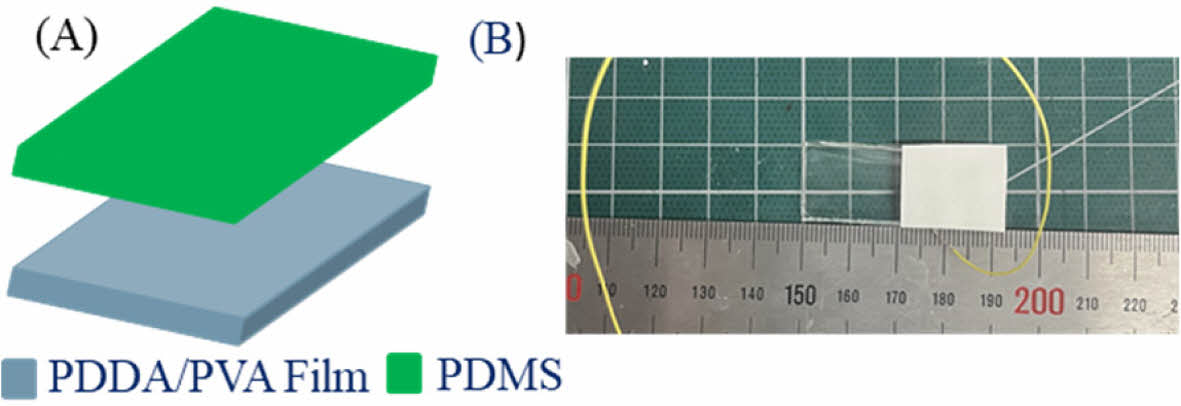
|
Fig. 1 Design layout of TENG mechanism (A) and PVA-PDDA free-standing film (B) |
3.1 Material Characterization
As illustrated in Fig. 2, FT-IR analysis provides valuable insight into the structural composition of the film. In the spectrum of neat PVA, the characteristic peaks at 3438 and 2930 cm-1 correspond to N-H/OH and C-H stretching, respectively. Additionally, the peaks at 1640 and 1091 cm-1 are assigned to C-C and C-O bending, respectively, confirming the presence of PVA (Fig. 2A) [7]. The FT-IR spectrum of PDDA exhibits peaks at 3355 (N-H and OH), 2930, and 1468 cm-1 (C-H stretching), confirming its distinct chemical fingerprint (Fig. 2B) [8]. Upon blending PVA and PDDA (PVA-PDDA), all characteristic peaks of the individual constituents are retained, indicating the successful incorporation of both polymers into the composite material (Fig. 2C). This FT-IR analysis highlights the compatibility and stability of the blended components in the composite films. This information is critical to understanding the molecular interactions within the composite and lays the foundation for further exploration of the material's properties and functionality.
The mechanical properties of the PVA-PDDA film are mainly influenced by the binding force between PVA and PDDA molecules, which is facilitated by hydrogen bonding [9]. As shown in Fig. 3, the stress-strain curves describe the behavior of free-standing PVA, PDDA, and PVA-PDDA films. In the case of the PVA-PDDA film, the calculated tensile modulus and elongation are significantly higher, 3.11 MPa and 308.4%, respectively. In contrast, the free-standing PVA and PDDA films exhibit lower tensile modulus values of 1.03 and 1.25 MPa, respectively, and the elongation results are 99.04% and 64.24%, respectively. This comparison highlights that both the tensile modulus and elongation are significantly enhanced by the blending of PVA and PDDA, suggesting the advantage of polymer blending in improving mechanical properties [10].
The transparency of the polymer films was evaluated through transmittance measurements using UV-Vis spectroscopy, as shown in Fig. 4A. The PVA-PDDA free-standing film exhibits a transmittance of 60% across visible wavelengths from 400 to 800 nm, demonstrating improved transparency over the individual components. Specifically, the PVA free-standing polymer shows a transmittance of 85%, while the PDDA exhibits only 20%, emphasizing the considerable improvement achieved through polymer blending [11]. This suggests that incorporating PDDA into the blend significantly enhances the overall transparency of the polymer film, which could be beneficial for applications requiring optical clarity and light transmission. Additionally, to directly compare the transparency of each free-standing film, it was visually depicted through photographic images with glass slides (Fig. 4B).
3.2 TENG Electrical Output Performances
The electrical analysis of free-standing films has revealed the complex mechanisms of the TENG, including contact electrification and electrostatic induction [12]. In the vertical contact-separation mode, the interaction of opposing triboelectric polarities occurs when two tribomaterial surfaces are subjected to an external load. When the load is removed, the potential difference initiates electron flow between the electrodes through an external circuit to seek equilibrium. When the load is reapplied, the potential difference is re-established, causing reverse current to flow. The cyclic interaction of these compression and release phases generates alternating output signals, demonstrating the dynamic energy harvesting capability of TENGs [13]. The data presented in Fig. 5 highlights the remarkable electrical performance of TENGs under fixed test conditions consisting of a contact force of 5 N, a gap distance of 5 mm, a contact frequency of 3 Hz, and a contact area of 2 × 2 cm². In particular, the voltage and current outputs of the PVA-PDDA reached 50 V and 5 μA, respectively, demonstrating a substantial enhancement over the individual PVA and PDDA neat polymers. PVA alone produced an output of 12 V and 0.4 µA, while PDDA produced 18 V and 0.7 µA. These findings emphasize the potential of the TENG system to significantly improve energy harvesting performance and contribute to the advancement of sustainable energy solutions [11, 14].
To demonstrate the output capacity of the TENG system in Fig. 6, an average of 20 LED light bulbs were connected. Subsequently, the AC output power was converted to DC power by a rectifier and connected to the light bulbs, demonstrating the power generating capability during the vertical contact-mode [15].
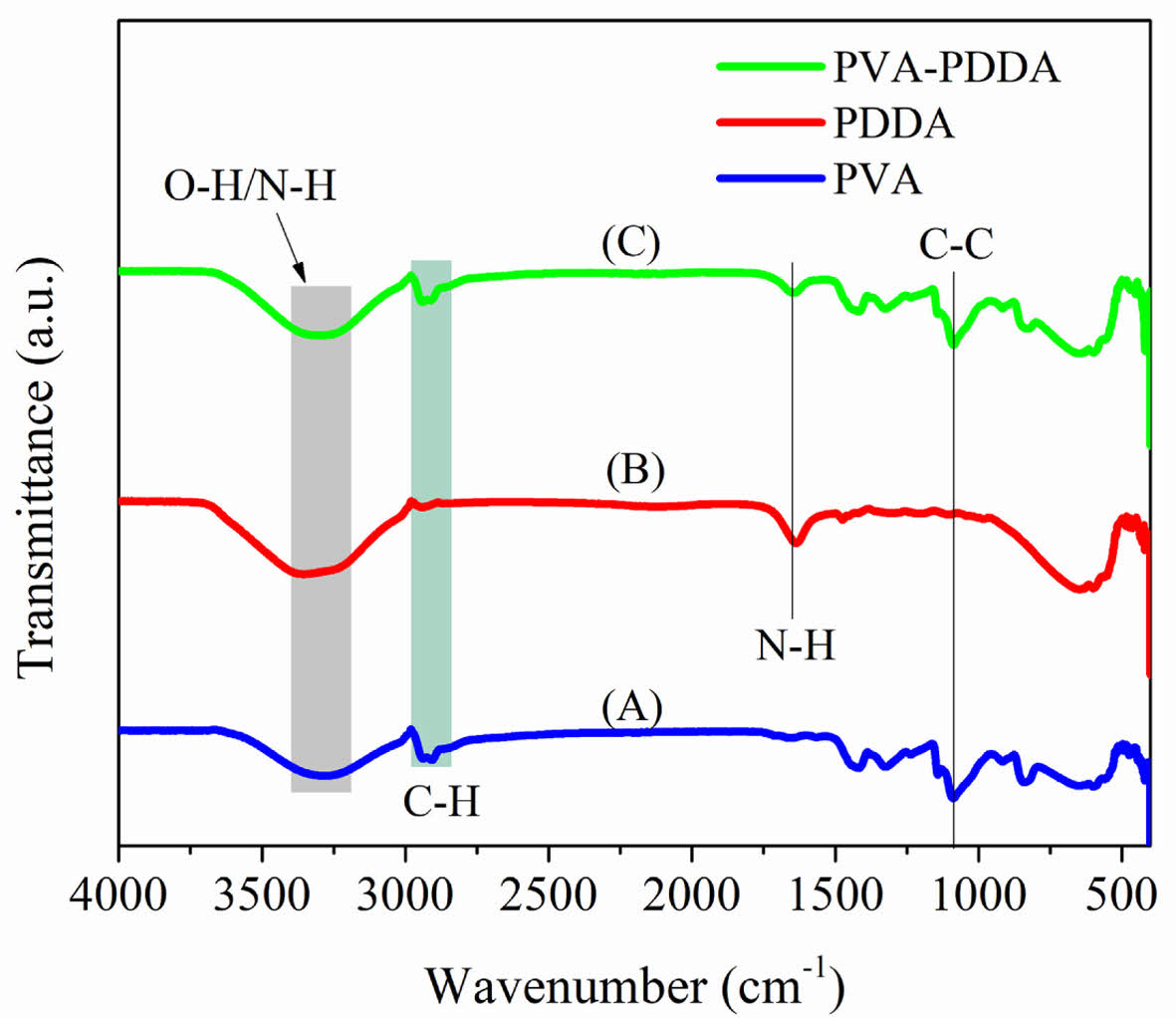
|
Fig. 2 FT-IR spectra of PVA (a), PDDA (b), and PVA-PDDA (c) freestanding films, respectively |
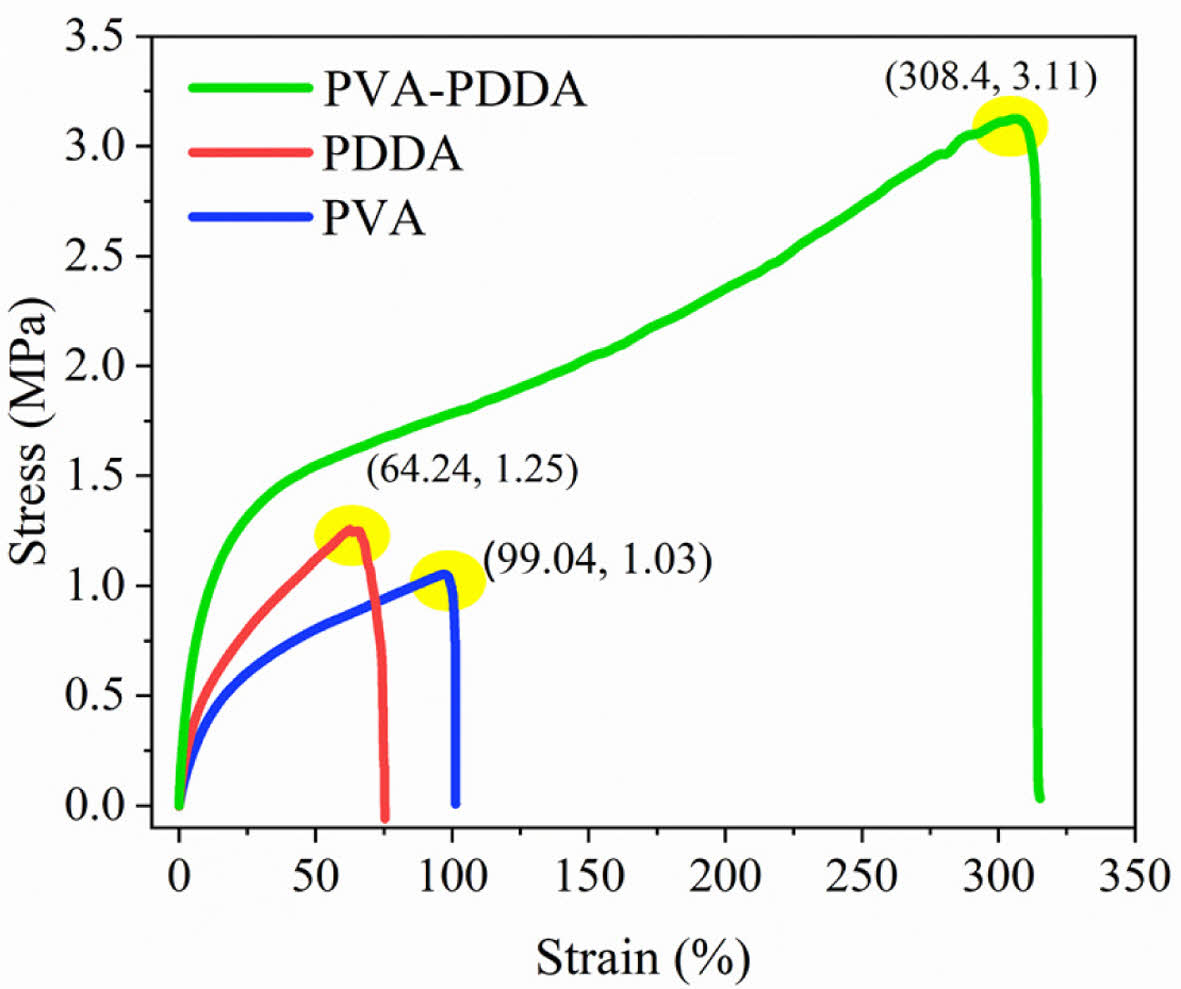
|
Fig. 3 Stress-strain curves of PVA, PDDA, and PVA-PDDA films |
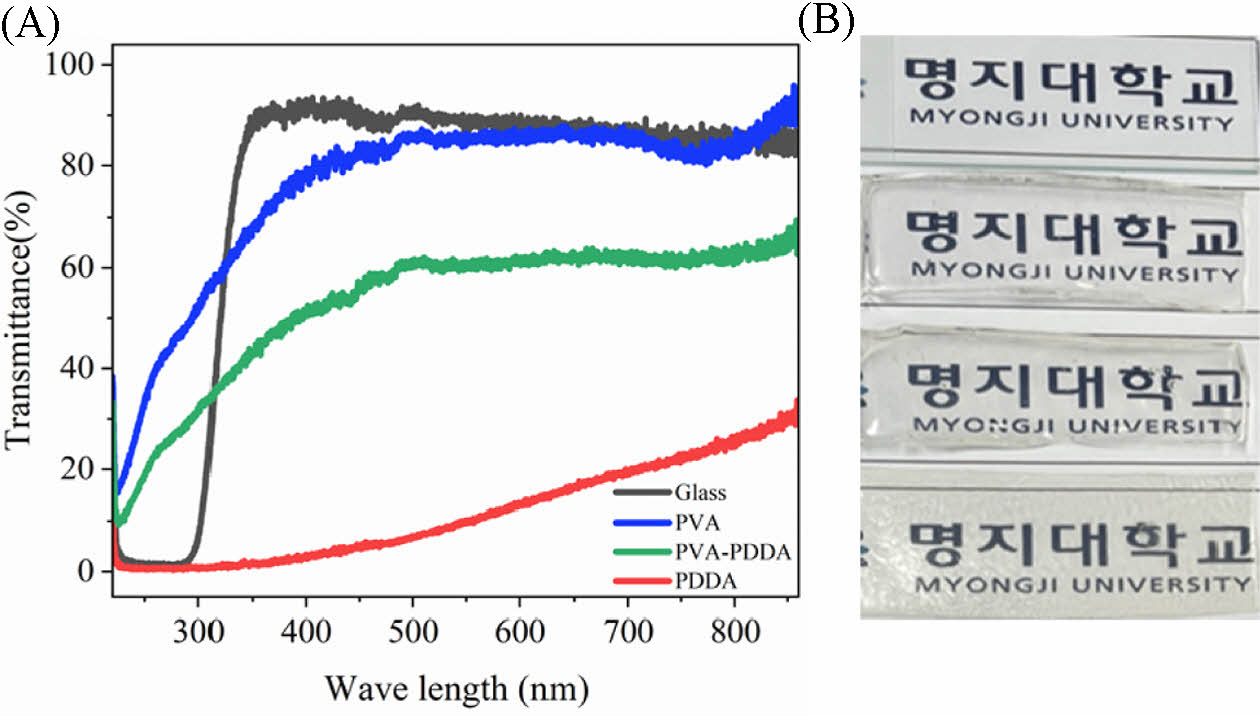
|
Fig. 4 UV-Vis light transmittance spectra (A) and top to bottom photographic images of glass, PVA, PVA-PDDA, and PDDA free-standing films (B) |
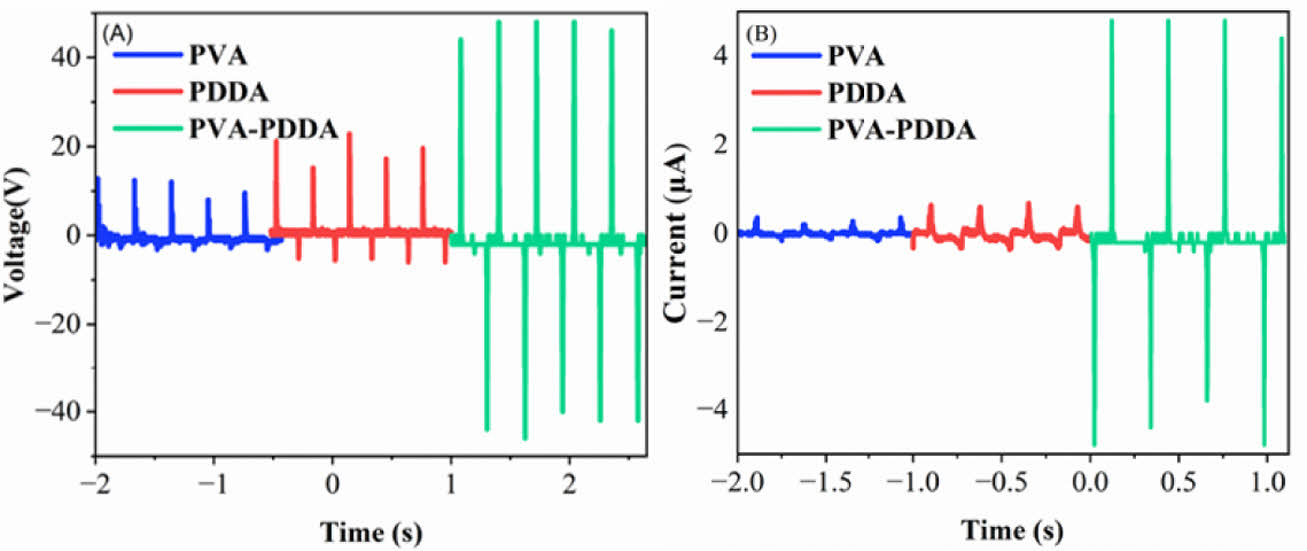
|
Fig. 5 TENG electrical output performance, output voltage (A) and current (B) |
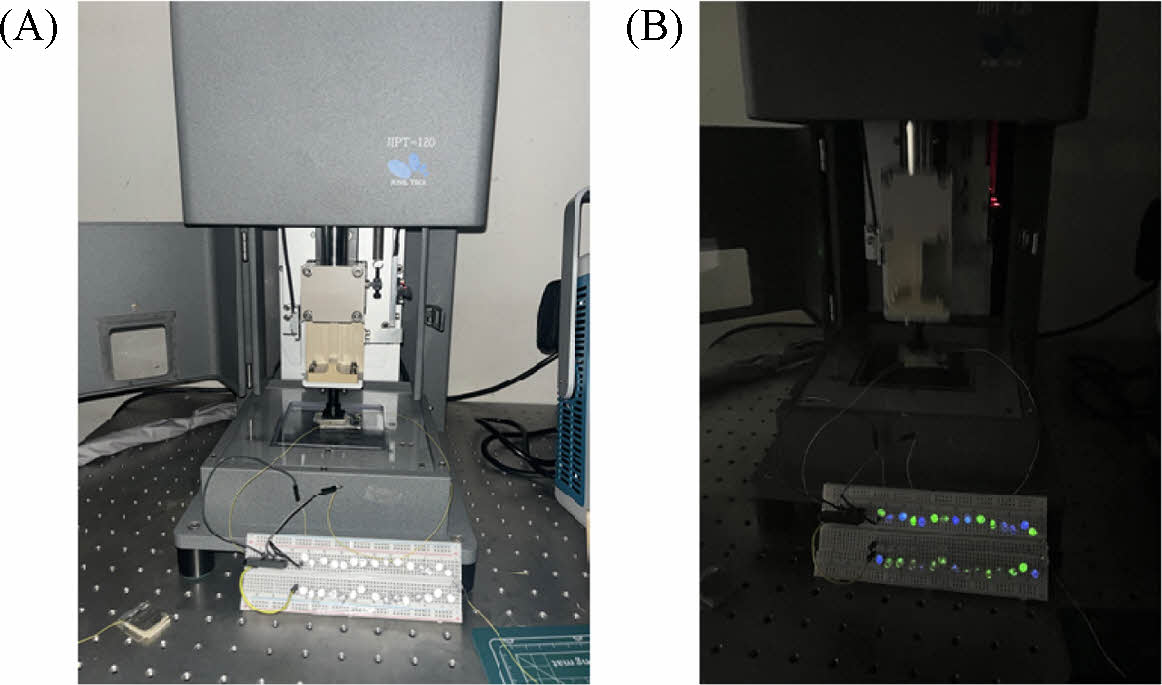
|
Fig. 6 Pushing tester (A) and illuminated LED light (B) for vertical contact-separation mode experimentation |
In conclusion, this study provided valuable insights into the mechanical properties, transparency, and energy harvesting capability of composite polymer films, with a particular focus on the blending of PVA and PDDA. Through a comprehensive analysis, it was observed that the incorporation of PDDA into the PVA matrix significantly improved the mechanical strength and stretchability of the composite films while maintaining good transparency. Furthermore, the electrical analysis of the free-standing films confirmed the remarkable energy harvesting performance of the TENG system. The voltage and current output of the PVA-PDDA was found to be significantly higher compared to the individual PVA and PDDA polymers, highlighting the effectiveness of polymer blending in enhancing triboelectric efficiency. The results obtained in this study highlight the potential of polymer blending as a strategy to improve the performance of composites in a variety of applications, including triboelectric energy harvesting. By understanding the complex mechanism of TENG operation and the effects of polymer blending on material properties, researchers can further optimize the design and development of energy harvesting technologies. Future research could explore additional polymer blending and fabrication technique to enhance the mechanical, optical, and electrical properties of composite films. Overall, the findings presented in this study may contribute to the advancement of sustainable energy solutions and pave the way for the development of innovative materials and technologies in the field of energy harvesting and beyond.
This work was supported by the National Research Foundation of Korea (NRF) grant funded by the Korea government (MSIP) (No. 2022R1A2C2006081) and by the Korea government (Ministry of Education) (No. RS-2023-00248677).
- 1. Menge, H.G., Jo, S.H., and Park, Y.T., “Layer-by-layer Self-assembled Thin Films for Triboelectric Energy Harvesting under Harsh Conditions,” ACS Applied Electronic Materials, Vol. 3, 2021, pp. 5475-5482. https://doi.org/10.1021/acsaelm. 1c00907.
-

- 2. Kim, D.W., Lee, J.H., Kim, J.K., and Jeong, U., “Material Aspects of Triboelectric Energy Generation and Sensors,” NPG Asia Materials, Vol. 12, 2020, 6. https://doi.org/10.1038/s41427-019-0176-0.
-

- 3. Zi, Y., and Wang, Z.L., “Nanogenerators: An Emerging Technology Towards Nanoenergy,” APL Materials, Vol. 5, 2017, 074103. https://doi.org/10.1063/1.4977208.
-

- 4. Li, S., Peng, W., Wang, J., Lin, L., Zi, Y., Zhang, G., and Wang, Z.L., “All-elastomer-based Triboelectric Nanogenerator as a Keyboard Cover to Harvest Typing Energy,” ACS Nano, Vol. 10, 2016, pp. 7973-7981. https://doi.org/10.1021/acsnano.6b03926.
-

- 5. Fan, F.R., Tian, Z.Q., and Wang, Z.L., “Flexible Triboelectric Generator,” Nano Energy, Vol. 1, 2012, pp. 328-334. https://doi.org/10.1016/j.nanoen.2012.01.004.
-

- 6. Pandit, S., Khilari, S., Bera, K., Pradhan, D., and Das, D., “Application of PVA-PDDA Polymer Electrolyte Composite Anion Exchange Membrane Separator for Improved Bioelectricity Production in a Single Chambered Microbial Fuel Cell,” Chemical Engineering Journal, Vol. 257, pp. 138-147.
-

- 7. Mansur, H.S., Sadahira, C.M., Souza, A.N., and Mansur, A.A.P., “FTIR Spectroscopy Characterization of Poly(vinyl alcohol) Hydrogel with Different Hydrolysis Degree and Chemically Crosslinked with Glutaraldehyde,” Materials Science and Engineering: C, Vol. 28, No. 4, 2008, pp. 539-548.
-

- 8. Chen, H., Wang, Y., Wang, Y., Dong, S., and Wang, E. “One-step Preparation and Characterization of PDDA-protected Gold Nanoparticles,” Polymer, Vol. 47, No. 2, 2006, pp. 763-766.
-

- 9. Sau, S., Pandit, S., and Kundu, S., “Crosslinked Poly (vinyl alcohol): Structural, Optical and Mechanical Properties,” Surfaces and Interfaces, Vol. 25, 2021, 101198.
-

- 10. Sharma, A., and Agarwal, P., “Experimental Study of Resistive Load for Impedance Matching of Triboelectric Energy Harvester Fabricated with Patterned Polydimethylsiloxane Polymer Layer,” SN Applied Sciences, Vol. 2, No. 6, 2020, 1058.
-

- 11. Wallner, G.M., Lang, R.W., Platzer, W., and Teichert, C., “Optical Properties of Polymer Films for Transparent Insulation,” Macromolecular Symposia, Vol. 181, No. 1, 2002, pp. 399-410.
-

- 12. Liu, W., Wang, Z., and Hu, C., “Advanced Designs for Output Improvement of Triboelectric Nanogenerator System,” Materials Today, Vol. 45, 2021, pp. 93-119.
-

- 13. Menge, H.G., Huynh, N.D., Cho, C., Choi, D., and Park, Y.T., “Designable Functional Polymer Nanocomposites via Layer-by-layer Assembly for Highly Deformable Power-boosted Triboelectric Nanogenerators,” Composites Part B: Engineering, Vol, 230, 2022, 109513.
-

- 14. Diaz, A.F., and Felix-Navarro, R.M., “A Semi-quantitative Tribo-electric Series for Polymeric Materials: The Influence of Chemical Structure and Properties,” Journal of Electrostatics, Vol. 62, No. 4, 2004, pp. 277-290.
-

- 15. He, X., Guo, H., Yue, X., Gao, J., Xi, Y., and Hu, C., “Improving Energy Conversion Efficiency for Triboelectric Nanogenerator with Capacitor Structure by Maximizing Surface Charge Density,” Nanoscale, Vol. 7, No. 5, 2015, pp. 1896-1903.
-

 This Article
This Article
-
2024; 37(2): 139-142
Published on Apr 30, 2024
- 10.7234/composres.2023.37.2.139
- Received on Mar 14, 2024
- Revised on Apr 17, 2024
- Accepted on Apr 23, 2024
 Services
Services
- Abstract
1. introduction
2. materials and methods
3. results and discussion
4. conclusions
- Acknowledgements
- References
- Full Text PDF
Shared
 Correspondence to
Correspondence to
- Yong Tae Park
-
Department of Mechanical Engineering, Myongji University, Yongin 17058, Korea
- E-mail: ytpark@mju.ac.kr






 Copyright ⓒ The Korean Society for Composite Materials. All rights reserved.
Copyright ⓒ The Korean Society for Composite Materials. All rights reserved.